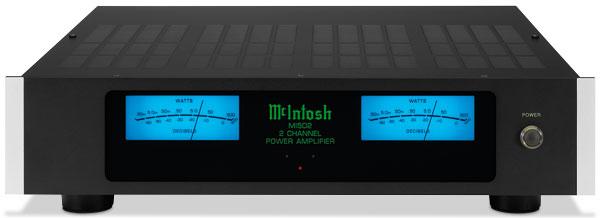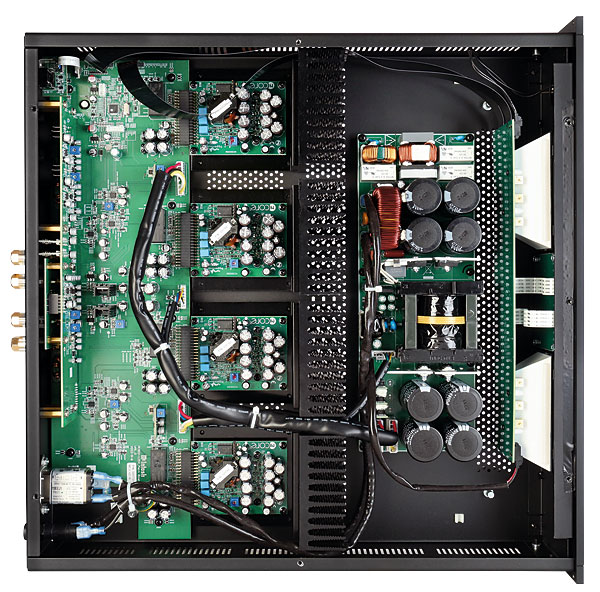McIntosh MI502 Class D Power Amp

 With its rack-mount 'ears' and 2U chassis, Mac's MI502 amplifier has its sights set on the custom install market. But is this Class D powerhouse also a treat for purist stereophiles?
With its rack-mount 'ears' and 2U chassis, Mac's MI502 amplifier has its sights set on the custom install market. But is this Class D powerhouse also a treat for purist stereophiles?
It's not unusual to find consumer hi-fi hardware making some concessions to the custom installation (CI) space – typically connectivity, such as RS232 and Ethernet – that enables a CI professional to integrate and control the product in a wider system. Yet there are also items, such as McIntosh's MI502, that are more deliberately aimed at the CI market. A slimline two-channel power amplifier, it looks a world away from some of the Binghamton, New York-based company's heavy-hitters. Should it be given a swerve by the dedicated audiophile? Or might it be just what the doctor ordered?
Certainly, the 2U form factor of the MI502 will make sense to some. Monstrous power amps with take-no-prisoners styling will always have their fans, but so too will svelte alternatives. Less likely to woo a hi-fi enthusiast is this amp's rack-mount potential: it's pre-fitted with rack 'ears' at each end so it can be securely installed in a 483mm (19in) rack system. These can be removed, however, trimming the width down to a more standard 445mm. It also ships with four pre-fitted feet, to be removed for a rack install but meaning a rack-top position is fine. All that's holding back the MI502 from being impressively discreet is the chassis depth, which is a considerable 533mm.
Flexible Friend
'The applications are nearly limitless for how to use the MI502', says McIntosh, but then reels off a list that includes powering the main front channels in a multichannel home cinema, driving a pair of passive subwoofers, or using multiple MI502s for multizone audio. Nowhere does its literature suggest making the MI502 the heart of your hi-fi, but that might be a case of the brand being reticent to draw attention away from the more 'traditional' models that have built its reputation. After all, this design claims a power output of 2x500W/8ohm, and offers all the (admittedly limited) bells and whistles you'd expect of an 'audiophile' power amp.
Ignoring McIntosh's many monoblock offerings (currently topped by the £49,500 three-box MC2KW) and its stable of stereo tube amps, the MI502's closest in-house relation would be the MC152, priced £6995 and rated at 2x150W. Therefore, if you're an adherent to the watts-per-pound philosophy, you'll be rubbing your hands with glee at the potential value for money here.

This power, and the MI502's small(ish) stature, is made possible by the use of Class D amplifier modules from Hypex, and associated switchmode power supplies – maybe it's this that encourages McIntosh to label it a CI product. Four of the Hypex devices are used, in balanced pairs.
Amenable Module
McIntosh's customary AutoFormer technology, where output terminals are provided for 8ohm, 4ohm and 2ohm speaker impedances, is also unnecessary here not least because the Hypex module's performance is remarkably speaker-agnostic. As such, the rear of the MI502 is about as uncluttered as it gets. Above a single set of gold-plated five-way binding posts is an unbalanced stereo phono input, while a balanced XLR input sits to the left alongside 12V in/out trigger ports that allow the amp to be switched on from a connected preamp automatically.
It's around the front that this amplifier looks a little more glamorous, as it features McIntosh's de rigueur black glass front panel, green illuminated logo/model name, and pair of blue 'Watt Meters'. Arguments rage about the merits of these flickering needles on hi-fi hardware, but PM's measurements found them to be accurate (into 8ohm), and I'm quite partial to the visual show. And the presence of the Watt Meters suggests that McIntosh isn't fully leaning into the CI world, sensibly imagining a more domesticated setting for the MI502 – because when sat in a rackroom, those meters will go unnoticed by all except a passing mouse…
Styling is agreeable, unless you're averse to the green/blue aesthetic, because the Watt Meters can't be dimmed without the MI502 connected to a McIntosh preamp, where the remote provides the option. The status LEDs for each channel, on the other hand, remain off when everything is running, but will switch to amber if a channel's maximum power output has been reached and clipping protection ('Loudspeaker Guard') has activated. A red LED signifies McIntosh's 'Sentry Monitor' system has kicked in, disengaging the output if a short circuit is detected.


















































